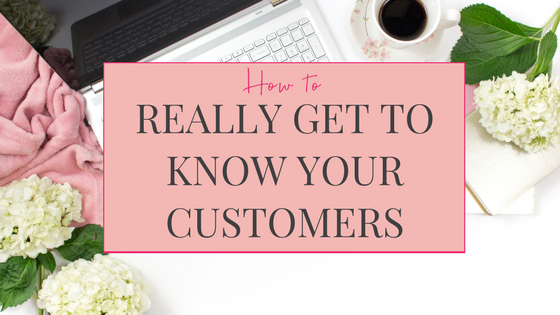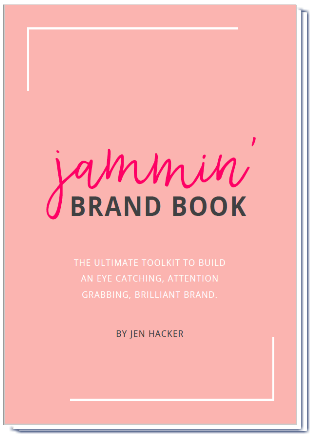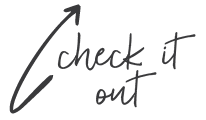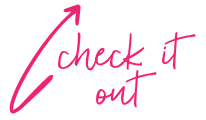
Do you really know who your customers are? This post is going to teach you how to make them your new BFFS with a super specific research process and a customer persona template.
Last week I posted about how to build your brand from the bottom up in 10 steps. I was really excited to share that because I wanted to give you all one source that covered it all.
If you haven’t yet checked that out I would recommended popping over here to read it.
While I’m in love with that post, I can freely admit that it came with two big challenges. First, it’s A LOT and might even feel like too much for you. And while yes, you’ll eventually need to go through each of the 10 steps, you won’t be tackling them all at once. Second, while I was able to provide some examples and resources, I didn’t get to go as in depth as I wanted to for each step.
For that reason, I want to take the next few weeks to tackle each of the 10 steps in it’s own blog post. Starting at the top with how to really get to know your customers.
Let’s get real for a minute.
How many of you struggle with the customer bit and figuring out who your brand is really for? Maybe you have an idea but aren’t totally sure. Or, perhaps you’re crystal clear about who you want to target but don’t know how to connect with them in an authentic way. Wherever you’re at in this process let’s all agree, getting to know your customers is CRITICAL.
Why is getting to know your customers so important?
- When you really know your customers you’ll know exactly what they need from you. This information is POWER. If you’re creating the right offerings you’ll get more sales.
- You’ll know how to sell to your customers in a way that isn’t salesy. When you can talk to your customers about how you’re going to help solve their biggest struggles or achieve their biggest dreams magic happens. You stop becoming a saleswoman and turn into a best friend.
- You will know when and where your customers want you to jump in. It’s the difference between your brand being an annoyance and a godsend.
Pretty good stuff, right?
On top of all of that, when you get this right, your customers will love you for it. So much in fact that they’ll want to tell the world about your brand. Because you’ve been so darn amazing for them they’ll want to let others into the secret. This is literally MONEY because you know what?
92% percent of consumers around the world say they trust word-of-mouth or recommendations from friends and family, above all other forms of advertising. [Nielsen]
Okay, by now I hope we can agree that getting to know our customers is a fundamental first step. The next question is what to do about it.
That’s what I want to tackle in the rest of this post. I’m sharing exactly the process that I use and that I want you to adopt too. I’ve also created a template you can use to build your customer personas. We’ll get to that in Step 10 but in the meantime, you can Click Here to Get Your Download
Alright, let’s get to it.
Create a place to keep all of the information you’re about to collect about your customers
You’re going to collect a lot of data throughout this process and I want you to have a system to keep it all organized.
I like to use a Google workbook but you can also use Excel. My workbook has two tabs. The first tab serves as a place where you can dump information as you find it. The second tab is where you can start to organize it. On this tab I want you to create columns for each of the places you’re going to pull data from. Google Analytics, Twitter, Facebook, Instagram, Brand A, Brand B, and Brand C are good places to start.
Across the side I want you to create these rows: age, location, interests & hobbies, wishes, and frustrations. This is the information you are going to start to gather about your customers through your research.
Check your Google & social media analytics
There is so much good information readily available at your fingertips.
Assuming you have a website you’ll want to make sure you’ve integrated Google Analytics. Here you’ll be able to find out information about who is coming to your site including their:
- Ages
- Gender
- Where they live
- Interests (like travel and design)
- Which content they’re reading the most
Google Analytics Academy is a great resource to checkout if you’re not familiar or comfortable using their tool.
The next stop are your social media analytics. Facebook, Twitter, Instagram, and Pinterest all have reporting dashboards. Here you can find out information about your followers on each of those platforms. Much of this will be similar information (age, gender, location) but there are unique insights each can also add. For instance, Pinterest Analytics can show you which other brands your followers also engage with on their platform.


Build a list of brands, books, and blogs that share your customers
Equipped with this information I want you to create a list of brands, blogs, and books that you believe share a similar audience as you.
- Brands: These could be direct competitors or folks who do something completely different but complimentary to you.
- Blogs: These are from media and influencers who cover the topics your audience is interested in
- Books: You’re looking for self help, how-to, and DIYs related to your industry.
Discover which blog posts are the top performers with Buzzsumo
Take your brand and blog lists and head over to Buzzsumo. Type one of the websites from your list into the search bar. Out will pop a list of their most shared blog posts. These are the topics that their audience found the most compelling. Repeat this process for each of the brands and blogs on your list. Add these links to your Google worksheet. Later, you’ll want to go back to these posts and look for comments that readers have left.

Tap into the conversations customers are having on social media
Next, I want you to take your list of brands and bloggers and follow each of them on social media. Look out for whichever platform they have the most engaged followers and don’t forget to look for Facebook groups.
Browse around to see what posts are getting the most engagement e.g. people are leaving comments and a conversation is taking place. These are hot topics that people care most about.

Mine Amazon customer reviews
For the last part of this investigation, I want you to head on over to Amazon to look up the books on your list. What you’re looking for here are the customer reviews and more specifically the 5 and 1 star reviews.
These reviews are going to tell you what people absolutely loved about the book. They will also tell you where they felt like the book let them down. The latter is particularly valuable because it reveals what your potential customers are craving and currently aren’t being served.


Read and copy comments
As you are going through Steps 4 – 6 your goal is to uncover what real customers are saying they want and need. When you come across a great insight, copy the user comment and add it to your Google worksheet.
This process is sometimes referred to as copy stalking. Essentially you are gathering the exact language your customers use when they ask their questions or talk about their struggles or desires.
This is where you really start to get to uncover amazing insights. People are literally telling you what gets them jazzed, what’s holding them back, and what they want from you. I mean oh mah gawd does it get better??

Ask your audience
Up to this point you’ve been using other people’s audiences to get to know your own. This can be really helpful especially if you haven’t yet built up a large customer base or following yourself.
That being said, we don’t want to ignore the customers you do have so let’s talk about how to best engage with them.
The first thing I’d recommend is sending out an email and a few social posts asking who would be up for giving you feedback. This is your support squad. Many of you probably know that I do this with Toast Meets Jam. Use this group as your sounding board when you have ideas you want input on.
The easiest way to get their feedback is to send surveys to them through a free tool like Google polls or Survey Monkey. I’d also suggest identifying a solid group that you can do one on interviews with. These don’t have to be formal. Ask if you can take someone out for coffee or hop on a Skype to get their thoughts.
The second thing I’d recommend is to regularly gather feedback from your audience through social media. Sprinkle questions and polls into what you’re posting to Twitter, Facebook, and Instagram. This is a great way to get immediate reactions and vet ideas as you go.
Analyze your findings
While you’re going through your discovery process you should be adding your findings into your Google worksheet. It should now look pretty filled with all of the great data and insights you’ve uncovered across your social networks and your look-a-like brands.
At this phase, you want to start to look for patterns in the information. For instance, is there a specific age group that kept coming up as you were looking at your analytics across platforms? Do you see similar questions coming up in the comments that you copied from other brand’s social feeds and blog comments?
What you’re going to discover here are your customer segments. These are the different types of customers your brand serves. It’s likely that you’ll have one core segment that really stands out and maybe 1 – 3 smaller segments also in the mix. For example, your biggest segment might be women, age 25 – 34, who live primarily in LA and are interested in yoga, health blogs, and volunteering. Another smaller segment might be women 35 – 44 who live in NY and are interested in shopping, travel, and beauty. You want to narrow in on 1 – 2 and no more than 4.
Write customer personas
Your final step is to take these segments and give each a persona. Start by giving each a name. Then describe who she is, what she likes to do, what she struggles with, and what she hopes to achieve. If you can include actual quotes from your copy stalking even better.
I also like to give each persona a picture because I think that it helps to really bring them to life. You can even take it a step further and create a mood board that depicts her lifestyle. Polyvore is a really fun tool for this.
To wrap it up
We kicked off this post talking about the benefits of getting to know your customers really well. I hope that the steps we walked through help you see how this can be true.
To make it even easier I’ve created a template you can use to guide you through this process and help you build your customer personas. You can Click Here to Get Your Download
Now off to you! What questions can I help answer? Drop ‘em below.
A toast to you,
Jen


































